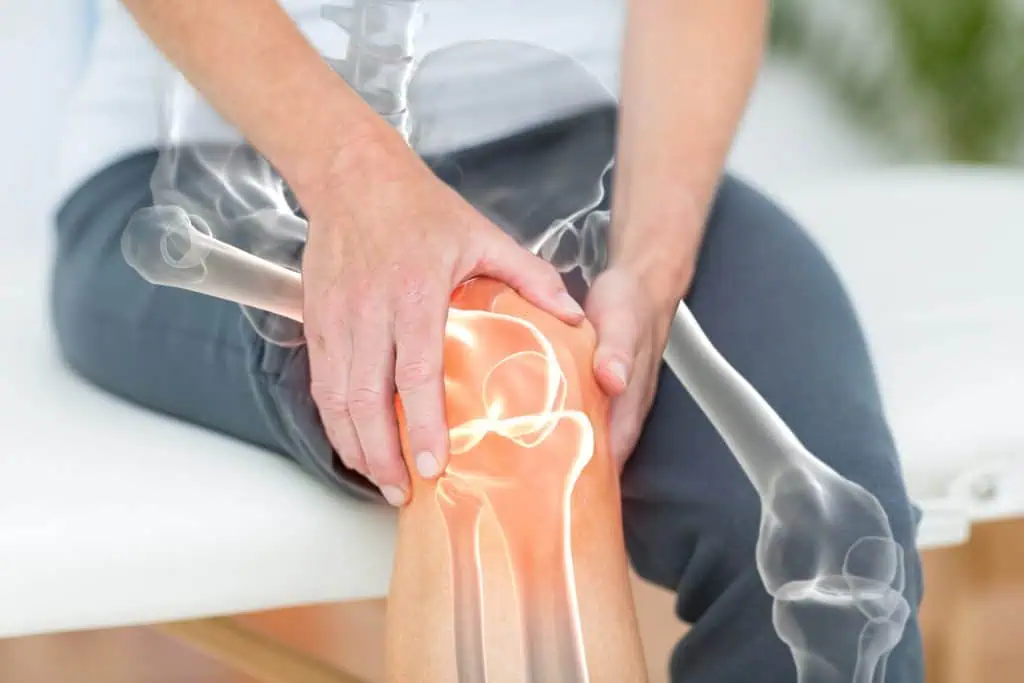Joint pain can significantly impact our daily lives, and understanding its causes is essential for managing discomfort and maintaining mobility. One lesser-known contributing factor to joint pain is the role of certain proteins in the body. While proteins are crucial for various bodily functions, including the repair and maintenance of tissues, specific types of proteins have been implicated in inflammatory responses that exacerbate joint pain.

Inflammatory markers like cytokines and proteins such as COMP (Cartilage Oligomeric Matrix Protein) are associated with joint health, and their imbalances can lead to symptoms of arthritis and other joint-related ailments. Research has shown that dietary choices can influence these proteins, highlighting the connection between what we eat and how our joints feel. As we navigate through various management strategies, from lifestyle adjustments to medical treatments, our understanding of the relationship between proteins and joint pain can empower us to make more informed decisions for our joint health.
Key Takeaways
- Certain proteins in the body are linked to inflammation and joint pain.
- Dietary choices can affect these proteins and potentially exacerbate or alleviate joint pain.
- Being informed on joint health can guide us through effective management strategies.
Understanding Joint Pain

In exploring joint pain, we’ll dive into the reasons why our joints may hurt, how proteins contribute to this discomfort, and the specific joints frequently impacted.
Causes and Risk Factors of Joint Pain
Joint pain can stem from a variety of sources—acute injury, chronic wear and tear, or underlying disease. As we age, our joint health can deteriorate, leading to discomfort. Injuries to the joints, whether sudden or due to overuse, can affect the ligaments and tendons, crucial components in maintaining joint integrity. Further risk factors encompass inflammation, often a natural response to injury or invasion of pathogens, and overuse of joints, particularly in athletes or in occupations requiring repetitive motion.
Relation Between Proteins and Joint Pain
Proteins play a multifaceted role in our body’s health, including that of our joints. Certain inflammatory proteins such as interleukin-1 and TNFα can increase inflammation, aggravating conditions like arthritis, thus leading to joint pain. On the flip side, dietary proteins, especially those containing omega-3 fatty acids, may actually help in reducing inflammation, offering some relief from joint discomfort. Understanding the complex influence of proteins on our ligaments and tendons is essential for addressing joint pain effectively.
Common Joints Affected by Pain
Our bodies contain several joints prone to pain due to various causes. The most commonly affected ones include the knees — which bear a significant portion of our weight — followed by the hips, shoulders, and spine. Issues in these joints may occur due to a variety of factors, including strain, degradation over time, or inflammatory conditions that target joint tissues. Identifying which joints are in distress and the nature of the discomfort can lead to more targeted and effective treatments.
What Protein causes joint Pain
We know that certain proteins play a crucial role in the health of our joints, and the presence or imbalance of these proteins can lead to pain and other symptoms. Here, we explore what protein causes joint pain, and how they affect our bodies.
Collagen and Joint Health
Collagen is the primary protein in our cartilage, contributing to the strength and elasticity of joints. When collagen deteriorates or its synthesis is disrupted, it can lead to weakened cartilage and increased joint pain. The direct link between collagen and joint health emphasizes the importance of this protein for maintaining the structure and function of our joints.
Cytokines and Inflammatory Response
Cytokines are signaling proteins that mediate and regulate immunity, inflammation, and hematopoiesis. Pro-inflammatory cytokines, like interleukin-1 (IL-1), can initiate and amplify inflammation within our joints, leading to pain and further promoting an inflammatory state. Balancing cytokine levels is vital to managing inflammatory responses in conditions such as arthritis.
Matrix Metalloproteinases and Cartilage Degradation
Matrix metalloproteinases (MMPs) are enzymes that are involved in the breakdown of extracellular matrix proteins like collagen. Excessive activity of MMPs can result in the degradation of cartilage, which is a hallmark of diseased joints. The presence of these enzymes in the synovial fluid and tissues within the joint space greatly influences the development and progression of joint pain.
Arthritis and Autoimmune Disorders
In this section, we’ll explore how different proteins and autoimmune responses are implicated in several forms of arthritis, a group of conditions that generally cause pain and inflammation in joints.
Rheumatoid Arthritis and Proteins
Rheumatoid arthritis (RA) is an autoimmune disease where the immune system mistakenly attacks our joints. Proteins such as inflammatory cytokines including interleukin-1 (IL-1) and tumor necrosis factor alpha (TNFα) are known to play a central role in the inflammation and joint damage seen in this condition.
Osteoarthritis: Wear and Tear
Unlike RA, osteoarthritis (OA) is primarily a degenerative disease characterized by the breakdown of cartilage and bone due to wear and tear. While not traditionally an autoimmune disorder, there’s growing evidence that inflammation, including that driven by synovial fibroblasts, contributes to OA pathology.
Gout and Uric Acid Crystals
Gout arises from the deposition of uric acid crystals in our joints, leading to intense episodes of inflammation and pain. Our body’s response to these crystals triggers an inflammatory cascade, not unlike an autoimmune reaction, though gout itself isn’t classified as such.
Psoriatic Arthritis Influence
Psoriatic arthritis is another autoimmune condition where our immune system causes joint pain and swelling. It often occurs in individuals with psoriasis and involves a complex interplay between genetics, the immune system, and environmental factors, leading to inflammation and joint damage.
Lupus and Systemic Inflammation
Lupus, or more specifically, Systemic Lupus Erythematosus (SLE), is a systemic autoimmune disease that can cause inflammation across various body parts, including the joints. People with lupus can experience joint pain and swelling, and in some cases, they develop lupus-related autoimmune arthritis due to the misguided attack by our immune system.
Diet and Nutritional Influences

Our dietary choices play a crucial role in the health and well-being of our joints. Specific nutrients can either promote joint health or exacerbate joint pain. By understanding which foods to embrace and which to limit, we can make informed decisions for our joint health.
Role of Diet in Joint Health
A balanced diet rich in certain nutrients can enhance joint health and potentially reduce the risk of inflammation. Omega-3 fatty acids, found in fish like salmon, can help reduce joint stiffness and pain. Moreover, Vitamin D and calcium are essential for bone density; dairy products can be good sources, and alternatives are available for those who are lactose intolerant or wish to avoid dairy for other reasons.
Inflammatory Foods and Joint Pain
On the other hand, certain foods can trigger inflammation, potentially leading to joint pain. Processed foods, which often contain sugar, purines, and nitrites, may increase inflammation and joint pain. To maintain a healthy weight and reduce stress on the joints, limiting these foods is key. Also, some proteins like casein in dairy products may contribute to inflammation for some individuals.
Beneficial Nutrients for Joints
Conversely, diets rich in antioxidants and fiber, found in fruits, vegetables, and nuts, support joint health by reducing inflammation. Omega-3 fatty acids are not just found in fish; they are also present in flaxseeds and walnuts. Incorporating a variety of these nutrients into our diet is part of an overall lifestyle change that can promote joint health and alleviate pain.
Lifestyle and Management Strategies

Managing joint pain involves several lifestyle modifications and management strategies. We’ll explore the role of exercise and weight management, the impact of lifestyle habits, and the potential benefits of alternative therapies and supplements.
Exercise and Weight Management
Exercise: Regular exercise is crucial for maintaining joint health. Low-impact activities such as swimming, cycling, and walking can increase strength and flexibility without exacerbating joint pain.
Weight Management: Maintaining a healthy weight is paramount. Weight loss can significantly reduce the stress on weight-bearing joints, thus decreasing pain and preventing additional damage. Even a small amount of weight loss can have a noticeable impact on joint pain relief.
Lifestyle Habits and Joint Pain
Diet: Incorporating anti-inflammatory foods into our diet, like fatty fish or olive oil, can help reduce joint inflammation. On the other hand, we should minimize the consumption of foods that might exacerbate joint pain, such as those high in sugars and saturated fats.
Smoking: Stopping smoking is crucial, as it can worsen joint pain by aggravating inflammation.
Alternative Therapies and Supplements
Therapies: Engaging in physical therapy can improve joint function. A therapist can tailor exercises to our needs, enhancing our mobility and strength.
Supplements: Some evidence suggests that supplements like omega-3 fatty acids might assist in reducing joint inflammation. However, we should always consult a healthcare provider before starting any new supplement to ensure it’s appropriate for our individual health needs.
Medical Treatment Options
When we discuss the medical management of joint pain, it’s important to understand that treatment options are multifaceted. They range from medications used to alleviate symptoms to advanced therapies targeting the underlying causes. We’ll delve into each of these areas to understand how they contribute to the overall treatment approach.
Medication and Side Effects
- Nonsteroidal Anti-Inflammatory Drugs (NSAIDs): We often turn to NSAIDs to reduce inflammation and relieve pain. Common examples include ibuprofen and naproxen. However, long-term use can lead to side effects such as stomach irritation, heart problems, and kidney damage.
- Corticosteroids: For more severe joint inflammation, corticosteroids are prescribed. While effective, potential side effects include weight gain, elevated blood sugar levels, and an increased risk of infections.
Targeted Treatments for Joint Pain
- Disease-Modifying Antirheumatic Drugs (DMARDs): We use DMARDs to slow or stop the immune system from attacking joints, which is a cause of inflammation. This can include traditional DMARDs like methotrexate and newer biologic drugs that target specific pathways in the immune system.
- Hyaluronic Acid Injections: Often used in treating knee osteoarthritis, these can provide pain relief by cushioning the joint.

Emerging Research and Therapies
- Biologic Agents: We are seeing a rise in the use of biologic agents that specifically target inflammatory cytokines, interrupting the inflammatory process at a cellular level.
- Stem Cell Therapy: Although still in research phases for joint pain, we are hopeful about the potential of stem cells in regenerating damaged tissues.
- Drug Discovery: Our ongoing research is aiming to discover new drug targets to provide more effective and safer treatment options for joint pain.
By keeping abreast with the latest medical treatments, we are better equipped to manage joint pain effectively and improve the quality of life for individuals suffering from arthritis and other joint-related conditions.
Frequently Asked Questions
We understand that navigating the role of proteins in joint health can be complex. The following frequently asked questions will clarify the association between certain proteins and joint pain.
What are the two proteins that have been associated with increased arthritis discomfort?
Two types of proteins, inflammatory cytokines such as interleukin-1 (IL-1) and tumor necrosis factor alpha (TNFα), have been implicated in causing increased discomfort in arthritis by promoting inflammation.
Can certain proteins in foods aggravate joint inflammation and pain?
Yes, proteins like casein found in dairy can aggravate joint inflammation and pain. Additionally, processed meats contain purines and nitrites, known to increase inflammation and pain in the joints.
Are there specific proteins commonly found in diets that may lead to osteoarthritis?
While no specific dietary proteins are directly linked to causing osteoarthritis, proteins that cause inflammation, like those found in red and processed meats, may contribute to the progression of the condition.
Is there evidence to suggest that egg protein contributes to joint pain and inflammation?
While egg whites are generally considered a safe source of protein for those with joint issues, the yolks contain arachidonic acid, which may contribute to inflammation if consumed in excessive amounts.
Which proteins should be avoided to reduce the risk of developing joint pain?
To minimize the risk of developing joint pain, it may be helpful to limit proteins that are high in purines or that boost inflammation, such as those found in red and processed meats. Opting for plant-based proteins or lean meats can be a healthier choice.
How does protein intake affect existing joint pain and arthritis symptoms?
An imbalanced intake of pro-inflammatory proteins, such as those from red meat and full-fat dairy products, may exacerbate arthritis symptoms. Conversely, proteins from fish, which are rich in omega-3 fatty acids, can help reduce inflammation and joint pain.















